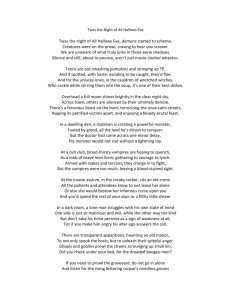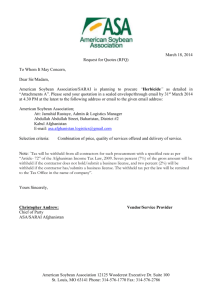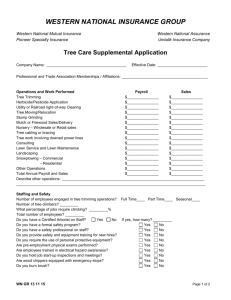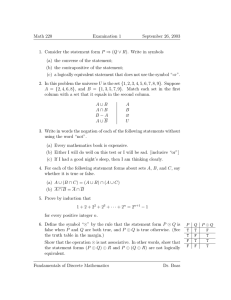Introduction
advertisement
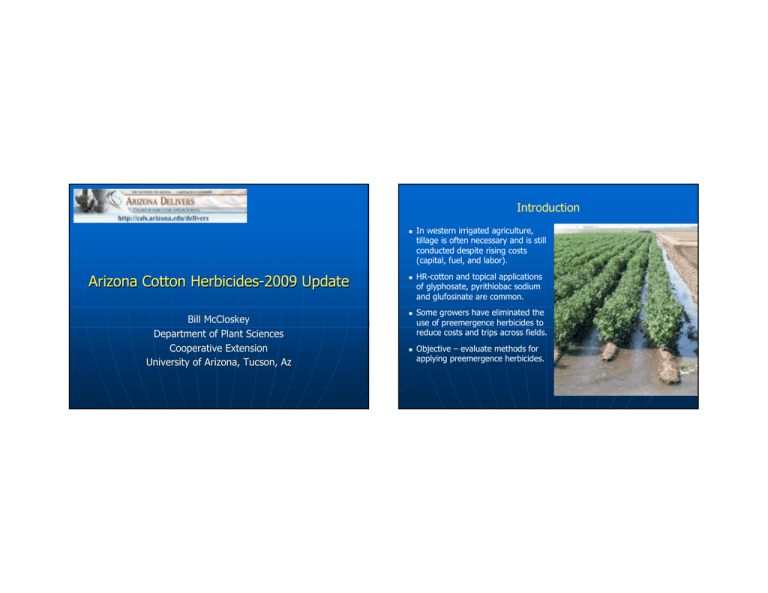
Introduction Arizona Cotton Herbicides-2009 Update Bill McCloskey Department of Plant Sciences Cooperative Extension University of Arizona, Tucson, Az In western irrigated agriculture, tillage is often necessary and is still conducted despite rising costs (capital, fuel, and labor). HR-cotton and topical applications of glyphosate, pyrithiobac sodium and glufosinate are common. Some growers have eliminated the use of preemergence herbicides to reduce costs and trips across fields. Objective – evaluate methods for applying preemergence herbicides. Roundup or other glyphosate herbicides are the most commonly used postemergence herbicides in tree crops and cotton and are now popular in many other RR crops. There are now 15 glyphosate resistant biotypes/species. Horseweed or marestail (Conyza canadensis) Glyphosate Tolerant/Resistant Horseweed Repeated low rate applications remove susceptible individuals leaving more resistant individuals to breed the next generation WeatherMax 22 oz, 2 d after application to 16 inch Palmer WMax 88 oz EPOST, 0.5” Managing Herbicide Resistant Weeds - WMax 88 oz MPOST, 3” Use management strategies that avoid total reliance on a single herbicide WMax 88 oz LPD, 10” IWM (integrated weed management) – use non-chemical control measures in addition to herbicides (e.g., cultivation). Use herbicide mixtures (use different mechanisms of action) or combinations of herbicides annually. Alternate or rotate herbicides with different target site from year to year or application to application. Herbicide rate – most important for herbicide resistance due to metabolism (as opposed to a resistant enzyme). Limit seed dispersal – containment and eradication of small resistant populations Cotton Weed Control Operations Preplant Tillage Pendimethalin, Prowl, Acumen Trifluralin, Treflan, Triap Prometryn, Caparol, Cotton Pro Diuron, Karmex Early POST topical or PD Mid POST Post-direct Layby PD broadcast Secondary Tillage Implements Broadcast Field Cultivator Prowl H20 (0.95 lb/A) applied PPI (field cultivator, listed, mulched, bed-shaped) NO Prowl H20 Experimental Procedures – Maricopa and Safford Application Methods for Soil Residual Herbicides Conventional tillage, pre- and post-season, and 2 or 3 inseason cultivations Standard small plot research: 4 row by various lengths, randomized complete block design, 4 to 6 replications, plots sprayed with tractor mounted sprayers Experiments were planted in April: • Dry planted at MAC • Wet planted at SAC • Herbicide treatments: glyphosate (w/AMS) applied topically, post-directed Chateau (flumioxazin) and Layby Pro at layby Ivyleaf Morningglory Canopy Infestation Maricopa Palmer Amaranth Infestation at Maricopa RR Flex+WeatherMAX Application Methods For Soil Residual Herbicides PreplantPreplant-incorporated, spray herbicide broadcast on level ground and incorporate prior to bed formation. PreplantPreplant-incorporated, spray herbicide band on listed beds before mulching (1 pass spray & mulch) and prior to bed shaping and planting. Application Methods For Soil Residual Herbicides Application Methods For Soil Residual Herbicides 2008 Safford Experiments Trifluralin, pendimethalin or no preemergence herbicide PPI flat (incorporated) • Trif. 1.13 pt/A • Acumen 1.5 pt/A PPI Mulcher • Trif 2.25 pt/A • Acumen 3 pt/A • 50% band – effective broadcast rates similar to above PreplantPreplant-incorporated, spray herbicide band on listed beds before mulching (1 pass spray & mulch) and prior to bed shaping and planting. 8001 or 80015 nozzles Higher pressure to avoid nozzle plugging. 1/2 to 2/3 band at broadcast rate Pendimethalin PPI-flat, PPI-mulcher & Preemergence Evaluated percent morningglory control – 7/14/8 Trifluralin PPIPPI-Mulcher Untreated control Trifluralin 0.56 lb ai/A Pendimethalin 0.62 lb ai/A Good Palmer Amaranth Control, Poor Late Season Morningglory Control % MG Control c Pend mulch b Trif mulch c Pend flat a Trif flat d control 0 10 20 30 40 50 60 70 Trifluralin 0.56 lb ai/A Pendimethalin 0.62 lb ai/A Trifluralin 0.56 lb ai/A Pendimethalin 0.62 lb ai/A % MG Infestation (ft MG/100 ft of row) Severity of MG Infestation bc Pend mulch b Pend flat ab Pend flat c Trif flat c Trif flat bc Trif mulch bc Trif mulch bc Pend mulch a control a control 0 0 20 40 60 80 100 10 20 30 40 50 60 70 80 90 100 May 25, 2005 – Safford Ag. Center Trifluralin 0.56 lb ai/A Pendimethalin 0.62 lb ai/A NO Prowl H2O 3.63 plants Seed Cotton (lb/A) m-2 Prowl H2O @ 0.95 lb/A 01.42 plants m-2 a Pend mulch a Trif mulch b Pend flat a Trif flat c control 0 500 1000 1500 2000 2500 3000 June 23, 2005 – A month after spraying topical herbicides, cultivating and irrigating, much more ivyleaf morninglory was emerging. Safford Ag. Center – 2005 Date Safford Ag. Center – 2005 & 2007 Prowl H2O (lb/A) Application method IPOHE density (plants/m2) 0 -- 3.6 0.95 (35 DAT) PPI-mulched 1.4 0 -- 48 0.95 (47 DAT) Topical spray 34 0.95 (84 DAT) PPI-mulched 5 May 25 July 13 Date May 25 2005 Dry Plant May 29 2007 Wet plant Prowl H2O (lb/A) Application method IPOHE density (plants/m2) 0 -- 3.6 0.95 (35 DAT) PPI-mulched 1.4 0 -- 2.2 0.95 (34 DAT) PPI-mulched 0.8 Maricopa Ag Center – 5/6/08 Maricopa Ag Center – 5/6/08 Maricopa Ag Center – 5/6/08 Maricopa Ag Center – 5/6/08 2 Morningglory heigth (cm) & # of true leaves Morningglory & Palmer Amaranth (#/m ) b Pend mulch Pend mulch b b Trif mulch Trif mulch c Pend flat Pend flat c Palmer A Trif flat MG control 20 40 60 80 100 Leaves c Trif flat Height a a control 0 0 bc c 1 2 3 4 220 200 180 160 140 120 100 80 60 40 20 0 No Prowl 8 6 4 2 0 No Prowl Prowl 2pt/A 2005 2006 2005 2006 2007 2005 2006 2007 Palmer Amaranth AMAPA Ivyleaf Morningglory IPOHE 5 4 3 2 1 0 No Prowl Prowl 2pt/A 2005 2006 Density (plants/sq. m) Prowl 2 pt/A Ivyleaf Morningglory true leaf no. Density (plants/sq. m) No Prowl Effect of Pendimethalin (0.95 lb/A) 1 Month After Planting at the Maricopa Agricultural Center Palmer Amaranth height (cm) Effect of Pendimethalin (0.95 lb/A) 1 Month After Planting at the Maricopa Agricultural Center Prowl 2 pt/A 220 200 180 160 140 120 100 80 60 40 20 0 2005 2006 2007 2005 2006 2007 Palmer Amaranth AMAPA Ivyleaf Morningglory IPOHE Cotton Weed Control Operations Conclusions Applying dinitroaniline herbicides with a rotomulcher during bed formation • Greatly reduced Palmer amaranth emergence. • Reduced ivyleaf morningglory emergence and reduced the number of leaves and size. • Not quite as effective as applying dinitroaniline on the flat prior to bed formation but good enough to protect yield when combined with postemergence herbicides. • Reduce the number of weeds emerging after each irrigation. Preplant Early POST topical Tillage Dual Magnum Pendimethalin, Prowl, Acumen Prowl H20 Trifluralin, Treflan, Triap Roundup, Touchdown, glyphosate Prometryn, Caparol, Cotton Pro Staple LX Diuron, Karmex Ignite 280 Post-Direct - MSMA Mid POST Post-direct Layby PD broadcast Postemergence: Cotton Up To 6 Inches Tall Roundup Ready Flex cotton varieties • Glyphosate @ 0.75 to 1.5 lb ae/A + AMS Topical & postpost-direct (drop(drop-tubes versus hoods) All cotton varieties (0 to 6” 6”) • Topical: Staple LX @ 2.5 to 3.8 oz/A (1.2 to 1.5 oz ai/A) + NIS (Season limit of 5.1 oz/A) • Topical: can use Dual Magnum (1.33 pt/A) for PREE control • PostPost-direct: MSMA @ 2.7 pt/A (2 lb ai/A) + NIS Liberty Link Cotton – Fibermax cotton varieties • Topical and postpost-direct (drop(drop-tubes versus hoods) Ignite 280 @ 29 to 43 oz/A (0.52 to 0.79 lb ai/A) Topical 43 oz/A fb postpost-direct 29 oz/A +Staple or MSMA Cotton Weed Control Operations Preplant Early POST topical Mid POST Post-direct Tillage Dual Magnum Glyphosate Pendimethalin Prowl H20 Staple LX Trifluralin Glyphosate Ignite 280 Prometryn Staple LX Sandea Diuron Ignite 280 Prometryn* Diuron* Layby Pro* Goal, GoalTender* Aim *Soil activity Chateau* ET Layby PD broadcast MidMid-Season PostPost-Directed Herbicide Options: Cotton 6 To 12 Inches Tall All cotton varieties (6” (6” to 12” 12”) • Diuron* Diuron* 0.8 pt/A (0.4 lb ai/A) + NIS • Goal* [GoalTender] Goal* 1-2 pt/A (0.25 to 0.5 lb ai/A) + NIS (Aim, Chateau, ET - more restrictive labels, hoods) • Layby Pro* Pro* 1.01.0-1.5 pt/A +NIS (cotton 8” 8” tall) • Sandea @ 0.670.67-1.33 oz/A (0.5(0.5-1 oz ai/A)+NIS (do not exceed 1.33 oz/A per yer/season) • Prometryn* Prometryn* 1 pt/A (0.5 lb ai/A) + NIS • Staple LX @ 2.52.5-3.8 oz/A (1.2 to 1.5 oz ai/A) + NIS Tank Mixes • Glyphosate 0.75 lb ae/A (RR), Ignite 29 to 43 oz/A (Liberty Cotton), can also use Dual Magnum PD for PREE control *Non*Non-selective “Chemical Hoe” Hoe” herbicides – Hoods, shields or accurate postpost-directed spray is necessary to avoid cotton injury. Cotton Weed Control Operations Preplant Early POST topical Mid POST Post-direct Layby PD broadcast Tillage Dual Magnum Glyphosate Glyphosate Pendimethalin Prowl H20 Staple LX Staple LX Trifluralin Glyphosate Ignite 280 Ignite 280 Prometryn Staple LX Sandea Prowl H2O* Diruon Ignite 280 Prometryn* Prometryn* Diuron* Diuron* Layby Pro* Layby Pro* Goal, GoalTender* Aim Goal, GoalTender* Aim Chateau* Chateau* ET ET *Preemergence soil activity Application Methods & Nozzles for Layby Herbicides Turbo FloodJet Nozzles • Wide angle flat spray tip • Large spray droplets • Excellent for preemergence herbicides with soil activity • Good for systemic herbicides • Not recommended for contact herbicides Cotton Layby Herbicides Layby PD broadcast Preemergence soil activity Foliar Herbicide type/activity Glyphosate NO Systemic Staple LX NO Systemic Ignite 280 NO Contact Prowl H2O Yes No POST activity Prometryn Yes Contact Diuron Yes Contact Layby Pro Yes Contact Goal, GoalTender Yes Contact Aim NO Contact Chateau YES Contact ET NO Contact Comparison of Micron Sizes for Various Items: (approximate values) Spray Droplet Management! Need knowledge of the product being used. Herbicide, Fungicide, Insecticide • Systemic • Contact What is the target? • • • • • Soil Grass Broadleaf (smooth, hairy, waxy) Leaf orientation – time of day Penetration into canopy pencil lead paper clip 2000 (µm) •150 850 (µm) staple toothbrush bristle sewing thread 420 (µm) 300 (µm) 150 (µm) human hair 100 (µm) 1/2 of spray volume = smaller droplets ••VMD VMD 1/2 of spray volume = larger droplets Important Droplet Statistics •Operational Area Droplet Size Categories ASABE Standard S572* • • • • • Category Symbol Color Code Dv0.1 (in microns) Dv0.5 (VMD) (in microns) Dv0.9 (in microns) Very Fine VF Red < 57 < 144 < 274 Fine F Orange 57 – 111 144 - 235 274 - 415 Medium M Yellow 112 - 149 236 - 340 416 - 579 Coarse C Blue 150 - 170 341 - 403 580 - 732 Very Coarse VC Green 171 - 215 404 - 502 733 - 790 Extremely Coarse XC White > 215 > 502 > 790 *Example data extracted from American Society of Agricultural Engineers (ASABE) Standard S572. Data is an average of three laser measuring instruments (Malvern, PMS, and PDPA) and is based on the following droplet size studies: 1) Womac, A.R., R.A. Maynard, I.W.Kirk.1999. Measurement variations in reference sprays for nozzle classification. classification. Transactions of the ASAE 42(3):60942(3):609-616 2) Womac, A.R., 2000. Quality control of standardized reference spray nozzles. Transactions of the ASAE 43(1):4743(1):47-56. Improving Coverage? Cotton Layby Herbicides Layby PD broadcast Preemergence soil activity Foliar Herbicide type/activity Glyphosate NO Systemic Staple LX NO Systemic Ignite 280 NO Contact Prowl H2O Yes No POST activity Prometryn Yes Contact Diuron Yes Contact Layby Pro Yes Contact Goal, GoalTender Yes Contact Aim NO Contact Chateau YES Contact ET NO Contact Hooded Sprayers – Redball 420 Layby Hooded Sprayer Hooded Sprayers We can achieve selectivity by partially or totally physically blocking postemergence herbicides from contacting crop foliage. •Example of postpost-directed herbicide applications in an annual row crop using a Redball 420 hood. Wylie Spray Shield Directed Sprayer PostPost-directed and Layby Herbicide Options: Cotton 15 to 24 Inches Tall or Greater Herbicide (add adjuvants) Soil Texture Aim – 1 to 1.6 oz/A no soil activity Chateau – 2 oz/A all, soil activity Diuron – 0.8 to 1.6 qt/A coarse and medium ET – 0.5 to 1 oz/A no soil activity Prometryn - 0.8 to 1.6 qt/A coarse and medium Goal – 0.5 lb ai/A all soil types Layby Pro (linuron, diuron) 1.61.6-2-2.4 pt/A (coarse, medium, fine) Prowl H2O 1.51.5-2-3 pt/A (coarse, medium, fine) if not applied preplant Tank mixes • PPO inhibitors (Aim, ET) + either prometryn or diuron • RR/glyphosate (e.g. grasses, nutsedges or large weeds) or Liberty Link Cotton/Ignite 280 Cotton Layby Herbicides Layby PD broadcast Preemergence soil activity Foliar Herbicide type/activity General Crop Rotation intervals Glyphosate NO Systemic None Staple LX NO Systemic Medium-Long Ignite 280 NO Contact Short Prowl H2O Yes No POST activity Medium-Long Prometryn* Yes Contact Short Diuron* Yes Contact Long Layby Pro* Yes Contact Short Goal, GoalTender* Yes Contact Long-small grains, Short labeled crops Aim NO Contact None-registered crops Chateau* YES Contact Short with tillage ET NO Contact Short (30 days) The best weed control programs include: Preplant incorporated dinitroaniline herbicide (Prowl or trifluralin) either before (disking) or after listing (mulcher). Early topical postpost-emergence herbicide application; use maximum rates. 2nd herbicide application after first postpost-planting irrigation Layby herbicide application that includes a residual herbicide

